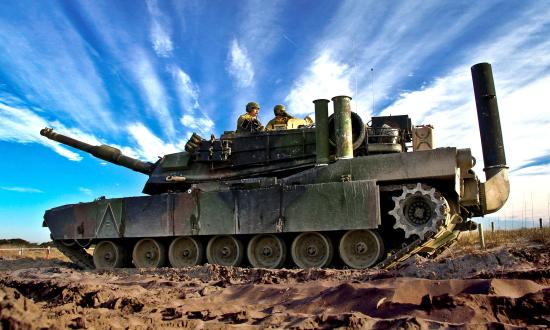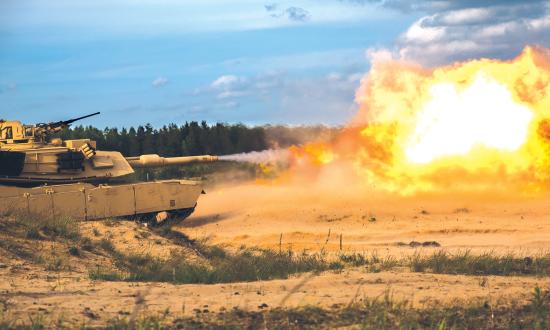The remarkable U.S. victory at Midway in June 1942 and the brutal battle for Guadalcanal from August 1942 to February 1943 radically altered the balance of power in the Pacific. As a result of these events, Japan adopted a strategically defensive/tactically offensive policy, seeking an opportunity to regain the initiative. The United States, on the other hand, sought to capitalize on the dramatic reversal of fortune, allowing the enemy no respite.
With this in mind, in return for U.S. support of allied operations in the Mediterranean, Admiral Ernest King and General George Marshall secured additional resources for the Pacific theater from the Combined Chiefs at the Casablanca Conference in January 1943. By late summer, general intentions had become specific objectives, and, at the Quebec Conference in August 1943, the Allied high command committed to a dual offensive against Japan. This two-pronged advance called for Australian and New Zealand Army Corps (ANZAC) forces in the southwest Pacific under the overall command of General Douglas MacArthur to advance on the New Guinea-Mindanao axis toward the Philippines, while Admiral Chester Nimitz gathered a mighty armada in the central Pacific and charted a course through the Gilberts, Marshalls, and Marianas. Thousands of man-hours were spent in planning and preparation taking into account every factor—except Japanese ingenuity and tenacity.
For the Navy and Marine Corps, the first step on the road to Japan was Tarawa. Operation Galvanic began with a week of intensive bombing by B-24s under the operational control of Admiral John H. Hooper. This was followed by air raids from the fast carriers of Task Force 58 prior to D-Day. On 18 November, carrier-based planes dropped 115 tons of bombs on the hapless islet. They struck again on 19 November with an additional 69 tons of ordnance plus 250 tons of high explosives from Cruiser Division 56.
On the morning of 20 November, three old battleships and five heavy cruisers of Rear Admiral Harry Hill’s bombardment group began the real show. Over the next four hours 3,000 tons of projectiles slammed into Betio. The entire island disappeared in flames and smoke. Barracks were destroyed, an ammunition dump was hit with spectacular results, and many enemy coastal defense guns were knocked out. Rear Admiral Howard F. Kingman boasted, “Gentlemen, we will not neutralize Betio. We will not destroy it. We will obliterate it.”1
Embarked Marines were elated. Unfortunately, their excitement was unfounded. In preparation for the inevitable American attack, the Japanese had dug gun emplacements, mortar and machine gun pits, and bomb shelters and constructed reinforced concrete command centers. Many of these were roofed with tough green coconut tree logs and covered with sand to absorb shellfire. Most of the Japanese weathered the storm of steel in these secure bombproof dugouts. Instead of conducting a mopping-up operation, the 2d Marine Division suffered 1,115 killed and 2,292 wounded, the highest casualty rate of any Marine unit during World War II (30 percent the first day, 17 percent overall). Of the 4,836 defenders, only 17 Japanese soldiers and 129 Korean laborers survived.
That tragic story was repeated in the Marianas and the Volcano Islands. Despite the tons of bombs that rained down on Saipan and the 2,400 14- and 16-inch shells hurled at it, the preliminary bombardment had little impact on its natural and man-made defenses. After 26 days of close-quarters combat, Saipan was secured, but at a cost of 3,400 killed and 13,100 wounded.
In the case of Iwo Jima, the Imperial Japanese Army began intense defensive preparations nearly a year prior to the invasion on 19 February 1945, creating a dense network of mutually supporting machine gun, mortar, and artillery bunkers with overlapping fields of fire connected by 11 miles of tunnels. To reach these strong points, the invaders first had to traverse carefully laid minefields. Storage facilities for food, water, and ammunition, medical facilities, mess halls, barracks, and command centers as much as 90 feet underground were carved out of the volcanic rock. Generators provided light and power for communication equipment. Consequently, the aerial and naval bombardment that began on 15 June 1944 had little effect.
With Japanese defenses more or less intact and little room to maneuver, the battle became a bloody, brutal slugfest. When Iwo Jima fell on 26 March 1945, for the first and only time during the Pacific war, U.S. casualties (dead and wounded) exceeded those of Japan.
The solution to the problem of a fanatical and resourceful enemy and ineffective aerial and naval bombardment was tanks. Initially, M3 Stuart and M4 Sherman tanks were used as direct-fire bunker busters and/or to provide covering fire so that sappers could get close enough to place their charges on Japanese strong points. In addition, improvised field modifications to some Sherman tanks gave them a limited flame-throwing capability. These measures proved so effective that Navy SeaBees began installing the Mark-1 flamethrower in the M4A3 Sherman. This modification gave the Sherman the ability to shoot a stream of napalm 150 yards through the 75-mm main gun. Without this valuable tool, the butcher’s bill at Iwo Jima would have been far worse.
Tanks also served Marines well in the Korean War, when hordes of T-34s swarmed over the 38th parallel, and again in retaking Hue City after the 1968 North Vietnamese Tet Offensive.
Despite this storied service, the Marine Corps has decided to divest itself of heavy armor and return to its “maritime roots” as light naval infantry. Contingent to this plan is an understanding that the Army will provide heavy armor if and when tanks are needed—all well and good if the Army has armor available and if the inevitable interservice communication problems and operational differences can be resolved in the heat of battle.
No doubt budget constraints are involved in this decision, as tanks are undeniably expensive to acquire and maintain. No doubt data was analyzed, assumptions made, and contingency plans drawn up. In the history of warfare, however, seldom do assumptions and plans correspond with reality. Battlefield experience indicates that sooner rather than later the Marine Corps will regret this decision.
1. LtGen William K. Jones, USMC (Ret.), A Brief History of the 6th Marines (Washington, DC: History and Museums Division, Headquarters, U.S. Marine Corps, 1987), 67.







